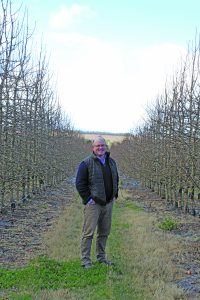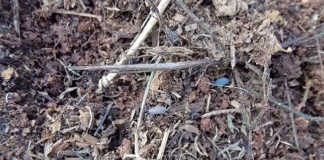
Photo: Supplied
The 1,5ha Cripps Red orchard that won Two-a-Day’s Stewart Murray Champagne Orchard Trophy earlier this year was manipulated to produce 157t of apples per hectare to help reduce plant vigour.
One would think such high yields would negatively impact packouts, but it did not. About 128t of the apples went to Two-a-Day’s packhouse, of which an impressive 94% was graded as Class 1.
What’s more, apple counts averaged at 135, which is the best count possible and means each apple measured between 67mm and 72mm in diameter.
The orchard, consisting of old strain Cripps Red on MM109 rootstock, was planted at Dunmanway Farm in Grabouw in 2016, at a density of 2 272 trees per hectare. Granny Smith is used as the pollinator, planted every third tree in every third row.
Cripps Red and Cripps Pink apples are related, with Cripps Red having a red instead of a pink blush. The apple itself, sold under the Sundowner trade name, has firm, crisp flesh, and a sweet-tart flavour.
Supportive environment
James Downes, owner of Dunmanway Farm, ascribes the success of the orchard to the cool climatic conditions of the farm, which favours the production of bicoloured apples. Along with this, all the farm’s orchards were planted on virgin soil.

As such, the land did not come with the soil health or disease ‘baggage’ associated with older, developed land. The advisory services provided by Two-a-Day’s technical support team, called Fruitmax, is another big contributor to the farm’s success.
“The pome fruit industry experienced an explosion of technological advancements in terms of varieties, orchard design and tree architecture since I joined the farm in September 1999.
“Fruitmax has production-based data on the performance of various varieties and management practices, which they use to inform farmers about what would work best under their circumstances.”
Family support
“Graeme Krige, and his team at Fruitmax, have helped our business remain competitive, as there is no way I would be able to navigate these changes on my own,” James says.
He also has a deep appreciation for the support, because he does not have a pome fruit production background: “My father, Keith, is seen as a pioneer in the pome fruit and dairy industries, because of the work he had done as the managing director at neighbouring Elgin Orchards.
“I, however, never thought there would be an opportunity for me to farm, so ended up studying selective breeding of salmon in Scotland,” he explains.
Keith bought the farm, which used to be a subdivision of Elgin Orchards, after a family meeting in 1997. During the meeting, he made it clear that either James or his older brother, Stuart, would have to come and help him once the orchards were established.
With Stuart being overseas at the time, marketing wine from Cono Sur vineyard and winery in Chile, James returned to Dunmanway and started planting vineyards in 2000.
“The grapes are processed and vinified at the Newton Johnson winery, and wine sold under our own Shannon Vineyards label, which pays homage to our Irish heritage,” James says.
He says there are about 75 new apple varieties being evaluated for planting internationally, with another 15 or so currently available for production in South Africa.
“To us this means we have not reached the end yet. There still is upside potential for on-farm improvement with these new varieties.”
To him, Cripps Red, combined with the new style of farming Cripps Red, is an example of how you can hit tonnage with high Class 1 packouts.
“Moving forward, varieties like these will be a farmer’s saviour from the cost-price squeeze. Production, unfortunately, will probably hit a ceiling in the next 20 years, if not already, as there is only so much you can get out of a hectare.”
James explains that he probably will never hit the high tonnages and packouts he did with the winning orchard in future, because his production target with the orchard lies between 125t/ha and 135t/ha.
“You need to find a balance between production and longevity. “If I rev this orchard in the red by continuously producing more than 135t/ha, it would affect the productive life of the orchard negatively. Optimal tonnages will vary based on the variety, the production environment and production practices,” he explains.
Improved variety
The farm has 35ha under pome fruit production. The apple varieties include old strains Royal Gala and Braeburn, along with Fuji, Pink Lady and Sundowner varieties that were planted up until 1997.
Improved Gala and Fuji strains and new varieties, such as Mahana Red, Kanzi, Rosy Glow, Lady in Red and Big Bucks have since been planted.
Forelle is the main pear variety planted, along with Cheeky, Abata Fetel and a little bit of Rosemary. They have 9ha under wine grape varieties, such as Pinot Noir, Merlot, Chardonnay, Semillon and Sauvignon Blanc.
To further diversify production, James’s wife Libby farms roses and dahlias that she sells through her flower business, Libby Farm Flowers.
Managing such a huge variety of fruit and cultivars is challenging, but James explains that the diversity allows him to use labour optimally. Their pome fruit-picking season starts in the first week of January, from when they pick every working day until the end of the season around 20 May.
The farm employs nine full-time people, including himself, and up to 60 seasonal workers. Cripps Red works well in his production package, as it is the last variety to come in, colours well, and is tough on the trees.
James explains that late varieties are often exposed to early winter storms and can blow off trees, whereas Cripps Red tends to stick.
“It really is an amazing, easy-to-manage variety.” The variety is also high bearing.
High yields
“Late varieties incur higher costs than early varieties, so you need high tonnages and a strong return per ton to cover these costs. Cripps Red ticks all the boxes; it has high yields, colour and Class 1 packouts, as well as amazing storage ability.
“It can be kept for up to a year under controlled atmosphere,” James says.
The variety also does not bruise easily, making it a great option for the African market, where apples are often sold on the road.
While many producers chase volumes from as early as possible, James manages his apple orchard to only produce commercial yields from when they are four years old.
Doing so allows growth to go into tree development instead of fruit production, gives the trees an extra year to fill the full tree volume up to 4,5m tall, and results in decent crops by the time the trees start maturing.
Sunburn
“We might only use the first 4m for bearing, but we want that extra height to protect the apples against sunburn,” he adds.
He stresses that this is especially important with basal dominant trees, like Cripps Red and Braeburn, which crop easily in the lateral branches.
“It is a crude explanation, but I usually tell my workers that the bottom third of the tree represents apples that will go to the juice market, the middle represents marketing and packaging costs, whereas the top third represents profit for the farm. It is easy to fill the bottom third, but difficult to fill the top third,” James explains.
The orchards are east facing, rendering the trees less vulnerable to sunburn than west-facing orchards. Along with this, adequate leaf coverage is left on the trees during pruning and thinning to protect fruit against sunburn.
“Some farmers prefer bare trees and others like leafy trees. I like vigorous, vibrant, leafy trees, which to me represent a full factory on the tree,” he says.
Cripps Red is quite precocious, which allows it to bare high yields on young wood. James, for this reason, does not do detailed pruning of the trees, but rather incorporates the technique of branch renewal.
As such, branches that have become less productive or too thick, compared to the main trunk, are removed annually through a cut, about three to four fingers from the trunk of the tree.
Soft bearing
“The emphasis is on creating soft bearing units, as these are more productive and produce better quality than old, fixed wood, as used in the old inverted T-tree designs,” James says.
The same practice is followed with Fuji, Kanzi, Braeburn and Pink Lady.
All the trees on the farm are under micro-sprinklers, with medium-range spitters with a range of about 1,5m. James explains that they have predominantly sandstone soils, which do not have a good water-holding capacity.
Hence, they need to be able to apply large volumes over short periods when necessary.
Their irrigation schedule is based on historic data, which is adjusted daily based on the physical observation of what is happening in the soil.
James points out that he had done away with probes, because of the huge variations in their soils: “Using only one or two probes does not give you a true picture of soil moisture levels in the whole of an orchard. You would need many more to account for variations. The poor holding capacity of the soil also leaves little margin for error.”
A fertiliser programme is used based on the productive stage and expected yields. In young orchards, they experiment with slow-release nitrogen-fixing legumes, serradella and bitter lupines to improve the soil.
Compost teas are also applied during the first four years of an orchard’s life to improve the soil and boost microbial life.
Labourers receive day rates plus bonuses per bin during the picking season, based on what they have picked in terms of bins to shed.
Farming with nature
Back in 2000, James was one of the first farmers in the Elgin region to start adding soil microbes, such as Trichoderma and mycorrhiza, to planting holes to boost plant and soil health.
According to Real IMP UK, Trichoderma protects plants by serving as a bionematicide, biofungicide and biofertiliser that promotes growth and the branching of crop roots.
The fungus is said to work by competing directly with pathogens for biological space on the plant, through parasitism of competing microbes and by enhancing plant immune systems.
Mycorrhiza, on the other hand, forms a symbiotic relationship with plants, whereby the fungi receive carbohydrates from the plant in exchange for enhanced water and nutrient uptake.
Once trees are planted, a sawdust mulch is applied in the growing rows. A proper, thick mulch is only applied the year after to ensure that roots grow deep first. Mulch is replaced every five years.
Mulch is made from trees on the farm, and bought in only from the Elgin region. No mulch is bought from areas further away, as James is afraid that the wood might be contaminated by pests or diseases, and specifically shot hole borer.
To this end, they also produce all their own firewood on the farm and use pine mulch, as pine trees have been shown not to harbour shot hole borer.
No herbicides are applied post-harvest, with the natural plants and grasses left to serve as cover crop in-between the planting rows to supress weeds and increase biodiversity. James also has a ‘good’ relationship with the baboons on the farm.
“As apex predators, they are true indicators as to the health of an environment. During the summer months, they mainly stay up in the mountains, and after harvest during the winter months they roam freely through the farm, picking up any left-behind fruit and so help ‘sanitise’ the orchards by removing this fruit.”
Email James Downes at [email protected].









